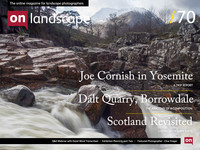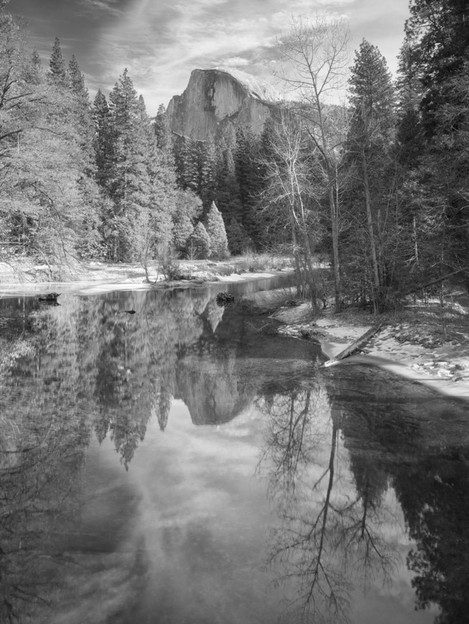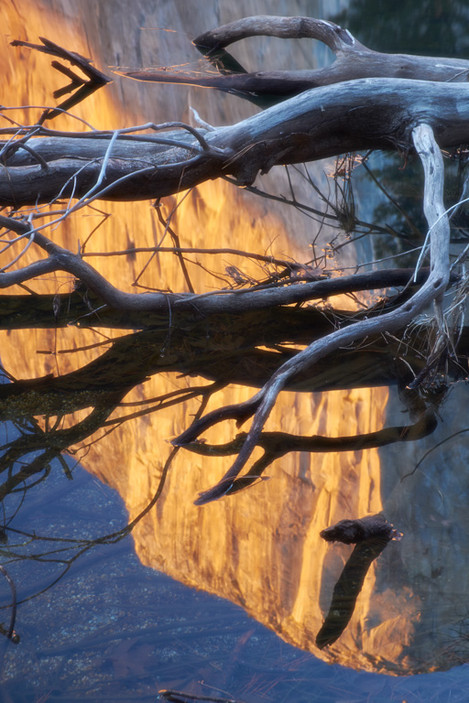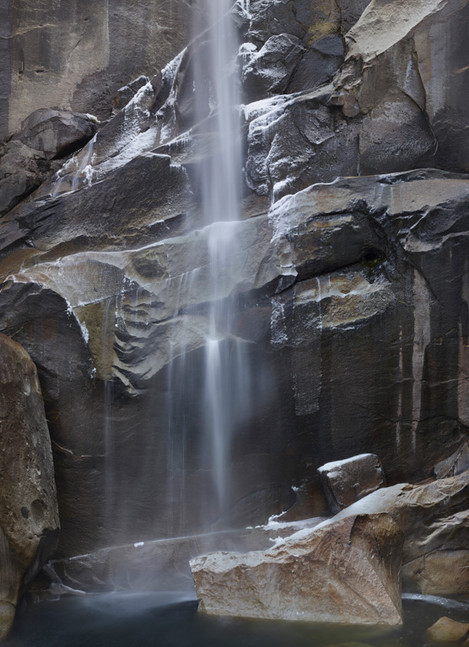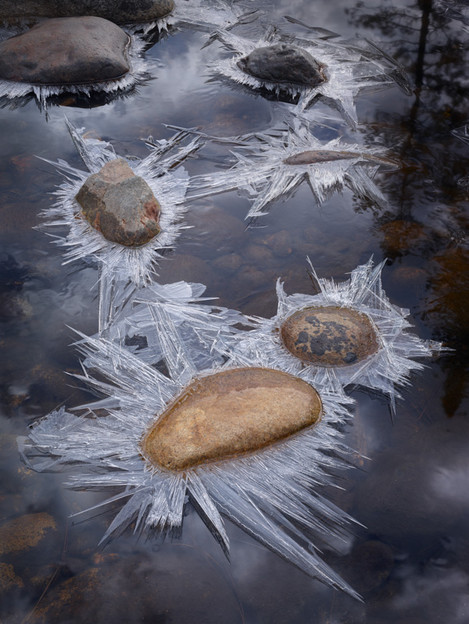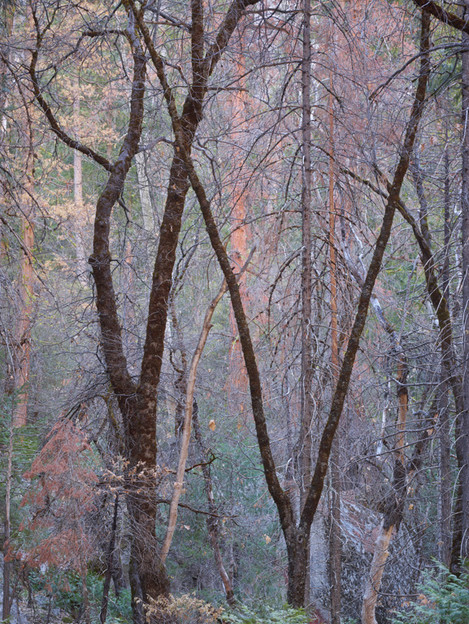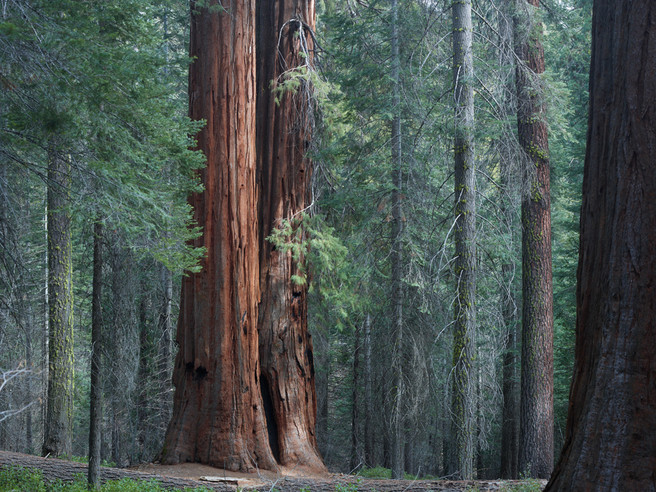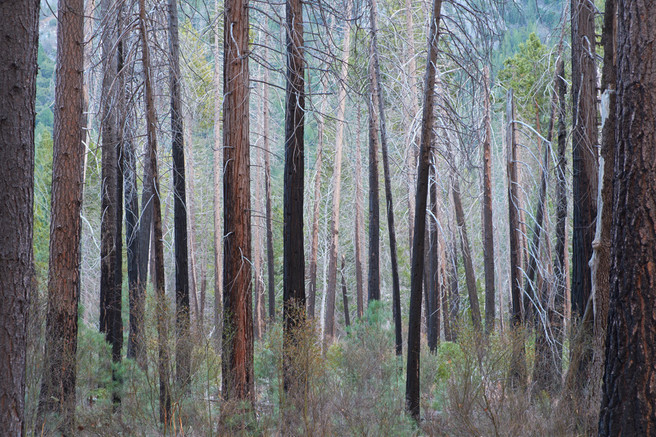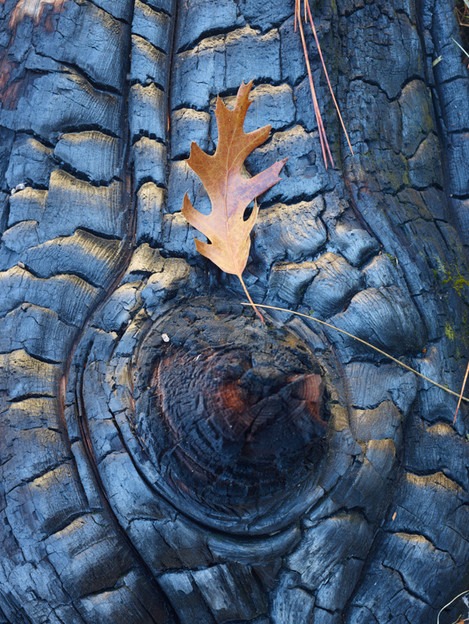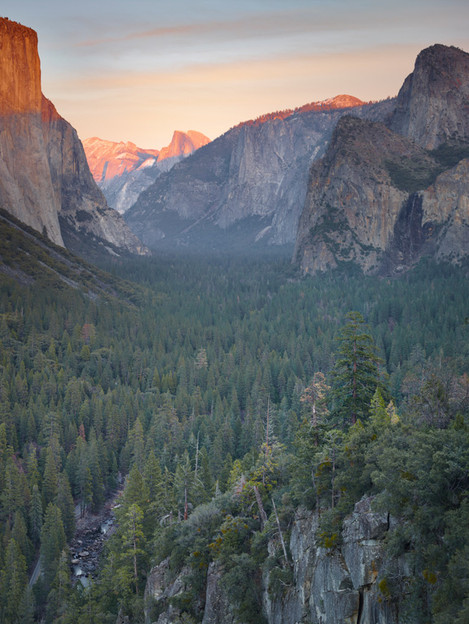Joe writes a report on a recent trip to Yosemite with David Ward
It really is difficult to elicit any sympathy or argue that life is hard when part of one's portfolio of tasks, labours and responsibilities involves travelling to California to lead a photographic workshop in Yosemite valley. David Ward and I have co-led tours, mainly for Light and Land, for many years and when Charlie Waite suggested “in the footsteps of Ansel Adams”, negotiation was unnecessary. We politely accepted. All photos were taken with the Phase IQ280 or Fuji X-E1
My previous visits to Yosemite had always felt slightly incomplete, unfinished. They had been in the summer, in mostly fine weather. I had never seen rain there, still less snow, and considering the shadow cast on my imagination by Ansel Adams' luminous, “Gates of the Valley, clearing winter storm” it seemed logical to me, to suggest winter. With considerably more experience of Yosemite than I, David was also in favour of the plan. Although we both know that, whatever the season, the weather is impossible to predict in the mountains, even in California.
Our small group of eight proved excellent companions. Tough too, as they had to be on the first day… having travelled eleven hours by plane to San Francisco they were then subjected to a rather elongated drive to Yosemite thanks to appalling Friday evening traffic, and subsequently a bit of navigational 'creativity' on our part. When we finally arrived at our Lodge near Yosemite Falls after 1am, never had the sight of staff at the desk still willing to check us in been so welcome.
All landscape photographers tend to have a love-hate relationship with the weather, however philosophical we know we should be; and an equally mixed relationship with the weather's forecasters too. We all knew about California's drought long before we arrived in San Francisco, and we also knew about the extraordinary depth of cold and wintery precipitation that was covering the eastern half of the United States just a short-ish flight away. Could the jet-stream shift west a bit please, and provide us with the cold and the snow in Yosemite, a landscape photographer's royal banquet, to feast on? To make things even more peculiar, we were all escaping from the UK's warmest, wettest, windiest winter of modern times, so surely, anything should be better than that?
The first day dawned cool and dry with light winds, but by the afternoon a powerful northerly airstream was drawing in dark clouds and snow started to settle on the giant trees that… stop!!!! wait a second. Sadly, that was my dream of what happened! In fact, the day continued cloudless, and by the afternoon was pleasantly warm. And if the UK forecasters have been almost apologising to us for the mayhem that has passed (in southern England and Wales especially) the last three months, they had the opposite problem in California; almost throughout our visit, to put it colloquially, it was weather-free.
The days were beautiful. We could travel where we wished, up to a point (although the high roads such as Glacier Point and Tioga Pass were simply closed for the season), and the most exceptional occurrence was the appearance of a few high clouds during the day. On some days these were enough to provide beautifully soft light, perfect for the forests. For anyone other than photographers it was as close to paradise as can be imagined if you are inspired by my mighty granite cliffs, magnificent trees and wonderful vistas. But somehow it was not quite what we had hoped for. In our hearts probably every one of our excellent group nurtured the small possibility that we too might witness a snowstorm clearing over the valley, or deep snow simplifying the marvels of the mighty sequoias in the Mariposa Grove. It never happened. The sun continued to smile down on us, as did the waning moon at night.
There were still wintery details to enjoy. The rain-starved Merced river was moving low within its course, and slowly too, allowing decayed snowbanks from the early winter to remain in situ and encourage the formation of adjacent ice overnight. The huge walls of the valley cast deep shadows through the winter, even at midday, and these shadows proved a salvation photographically. Vernal Falls, a usually sun-bleached tumult of water that is the reward for a committed walk, had been reduced to a frayed white ribbon; but revealed around it was the superb rock face normally hidden by the Vernal cataract. And that rock was in itself a wonder to behold.
On the day we chose to drive to Mariposa, where Yosemite's largest grove of giant sequoias can be found, our sharp-eyed leading driver (not me!) spotted a brilliant cluster of ice formations surrounding river boulders in the Merced's Southern Fork. This provided an unexpected session, and one of our most productive.
For anyone who has not been to Yosemite, it is worth describing a little more of what the experience is like. The majority of the park is mountainous, much of it covered in trees, especially on the lower western slopes. This is granite country, indeed it is the textbook example of a granite region and the valley is simply the most intense expression of its geology. Most of the park away from the roads and the valley remains wild, very wild, and enjoys the highest level of protection that American law can give. For the most part, its animals still do well here and although they are more abundant in the summer months we were fortunate to see a bear, several coyotes, a lynx and a large number of deer. But for all the Park's wildness, the valley itself is dominated by people. Among the trees is Yosemite village with thriving shops, cafes and a deli (as well as the Ansel Adams gallery), one hotel, one motel and a huge mix of camping and chalet style-accommodation at Curry Village. Many thousands of people can be accommodated, and even on a weekday in the middle of January, the valley can feel almost urban in human numbers, albeit an urban place of huge trees and amazing vistas in all directions!
To experience anything approaching the feeling of wilderness that the Park does in fact contain it is necessary to walk, to walk a long way, far from the well-known viewpoints and waterfalls. One of our first goals was Mirror Lake which is a couple of miles east of where the road ends. On that first day, we never got far; it became a standing joke, “Today, we are going to Mirror Lake!” as we kept postponing the endeavour. Then on the last day, we actually did it, and partly because we wandered some way away from where we should have been, we found ourselves under a gigantic landslide, almost immediately below (the now seriously foreshortened perspective of) Half Dome. Although still on a track, and being a group of ten, we had the place to ourselves for an hour or so and it was magically quiet. When we did finally return to Mirror Lake, which we had overshot, not recognising the dry flats where it should have been, many others had now gathered, including families with young children, and the atmosphere was… well, like a city park.
Another special highlight was the Merced Grove of giant sequoias. Although not a long hike, the grove's sheltered valley provided a sense of adventure to actually get there (would we see a bear?), and (the slightly oxygen-thin) climb back out after a number of happy hours with our cameras reminded us that we were not in fact at sea level. The peacefulness of it all, and the atmosphere of the place, hugely enhanced (literally) by the giant redwoods themselves was really memorable. Awe-inspiring is indeed an over-used phrase; but in the case of the sequoias, even these words can scarcely do them justice.
Parts of the valley, and the surrounding high country, show evidence of the fires that swept through here last summer. Fire is a mixed blessing in Yosemite, a necessity for sequoia who depend on it to launch the growth cycle of their seedlings. But when it rages too hot and long it also damages soil structure and condemns whole zones of the forest to long, difficult periods of recovery. One area we passed en route to Crane Flat we named the Desolation of Smaug. Yet I personally found the forested areas in the valley where recent fires had scorched many trees without killing them, and cleared the understorey – and promoted vigorous new growth – to have both visual beauty and symbolic meaning.
If our dreams of Yosemite in winter did not actually turn out as we expected, that should hardly be surprising. It is worth remembering that Ansel Adams himself lived and worked here (as a ranger as well as a photographer) for eight years, in addition to the hundreds of individual additional visits that he made. His work reflects a lifetime of devotion to the valley. Yosemite itself might be termed the ultimate Muse in landscape photography. Its grandeur can barely be explained in a photograph, even great ones like “Gates of the Valley”, and for us to have enjoyed conditions such as Ansel witnessed on that occasion would, on reflection, have been phenomenally lucky. As it is, we should really focus on the drought now afflicting California (and the wildfires that have raged out of control, even during the winter period). It is after all part of the same strange weather pattern that gave icy winter storms to the warm states of the American southeast, unseasonably mild weather in the high Arctic, and hurricane force winds and flooding in the UK. These events give serious pause for thought.
Yosemite remains a landscape conjured up in the imagination of artists, the darling territory of a nation, almost overexposed by its own celebrity. Yet for all its crowds, and unrealised dreams, it remains able to surprise and delight. It is aloof from the politics of climate change, above the short term concerns of individual human lives. And although geologically all landscapes are temporary, few places have its power to evoke an eternity, to help put ourselves in perspective. It still it draws us back. It always will.

